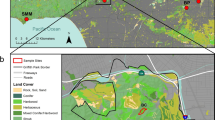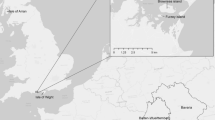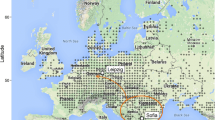Abstract
The European ground squirrel (EGS) (Spermophilus citellus) populations of Vojvodina (Serbia) represent the southernmost part of its distribution in the Pannonian lowland. For species with low dispersal abilities a presence of even weak barriers can have significant influence on genetic structure among adjacent populations. We examined here the effects of habitat fragmentation and river barriers on the genetic structure of the EGS based on 12 microsatellite loci. Bayesian clustering methods were used as additions to classical population genetic approaches. We found that EGS populations in Vojvodina are highly fragmented, but their genetic variation is still higher than in peripheral populations in Central Europe. Populations in Vojvodina consistently grouped into three genetic clusters. The Danube, but not the Tisza River, represents an important barrier to gene flow. EGS populations in the studied area did not show the signs of recent genetic bottlenecks, as would be expected from observations of recent population declines. Conservation strategy should be focused on maintenance of remained suitable habitats and optimal population sizes.



Similar content being viewed by others
References
Belkhir K, Borsa P, Chikhi L, Raufaste N, Bonhomme F (1996–2004) GENETIX 4.05, logiciel sous Windows TM pour la génétique des populations. Montpellier: Laboratoire Génome, Populations, Interactions, CNRS UMR 5171, Université de Montpellier II, Montpellier (France)
Bell KC, Matocq MD (2011) Regional genetic subdivision in the Mohave ground squirrel: evidence of historic isolation and ongoing connectivity in a Mojave Desert endemic. Anim Conserv 14:371–381
Bryja J, Granjon L, Dobigny G, Patzenhauerová H, Konečný A, Duplantier JM, Gauthier P, Colyn M, Durnez L, Lalis A, Nicolas V (2010) Plio-Pleistocene history of West African Sudanian savanna and the phylogeography of the Praomys daltoni complex (Rodentia): the environment/geography/genetic interplay. Mol Ecol 19:4783–4799
Busch JD, Waser PM, DeWoody JA (2007) Recent demographic bottlenecks are not accompanied by a genetic signature in banner-tailed kangaroo rats (Dipodomys spectabilis). Mol Ecol 16:2450–2462
Chapuis MP, Estoup A (2007) Microsatellite null alleles and estimation of population differentiation. Mol Biol Evol 24:621–631
Ćirović D, Ćosić N (2011) Viability of the European ground squirrel (Spermophilus citellus L. 1766) populations in Serbia—final report. Ministry of Environment and Spatial Planing, Republic of Serbia
Corander J, Marttinen P, Sirén J, Tang J (2008) Enhanced Bayesian modelling in BAPS software for learning genetic structures of populations. BMC Bioinformatics 9:539
Cornuet JM, Luikart G (1996) Description and power analysis of two tests for detecting recent population bottlenecks from allele frequency data. Genetics 144:2001–2014
Coroiu C, Kryštufek B, Vohralík V, Zagorodnyuk I (2008) Spermophilus citellus. In: IUCN 2011. IUCN red list of threatened species. Version 2011.2. http://www.iucnredlist.org. Accessed 21 Oct 2011
Dempster AP, Laird NM, Rubin DB (1977) Maximum likelihood from incomplete data via the EM algorithm. J R Stat Soc B 39:1–38
Djan M, Obreht D, Vapa Lj (2006) Polymorphism of mtDNA regions in brown hare (Lepus europaeus) from Vojvodina (Serbia and Montenegro). Eur J Wildl Res 52:288–291
Eckert CG, Samis KE, Lougheed SC (2008) Genetic variation across species’ geographic ranges: the central-marginal hypothesis and beyond. Mol Ecol 17:1170–1188
Evanno G, Regnaut S, Goudet J (2005) Detecting the number of clusters of individuals using the software STRUCTURE: a simulation study. Mol Ecol 14:2611–2620
Excoffier L, Laval G, Schneider S (2005) ARLEQUIN ver. 3.0: an integrated software package for population genetics data analysis. Evol Bioinform Online 1:47–50
Falush D, Stephens M, Pritchard JK (2003) Inference of population structure using multilocus genotype data: linked loci and correlated allele frequencies. Genetics 164:1567–1587
Fontaine MC, Baird SJE, Piry S, Ray N, Tolley KA, Duke S, Birkun A Jr, Ferreira M, Jauniaux T, Lavona A, Öztürk B, Öztürk AA, Ridoux V, Rogan E, Sequeira M, Siebert U, Vikingsson GA, Bouquegneau JM, Michaux JR (2007) Rise of oceanographic barriers in continuous populations of a cetacean: the genetic structure of harbour porpoises in Old World waters. BMC Biol 5(30):1–16
Frankham R (1996) Relationship of genetic variation to population size in wildlife. Conserv Biol 10:1500–1508
Frankham R, Ballou JD, Briscoe DA (2002) Introduction to conservation genetics. Cambridge University Press, Cambridge
Garner A, Rachlow JL, Waits LP (2005) Genetic diversity and population divergence in fragmented habitats: conservation of Idaho ground squirrel. Conserv Genet 6:759–774
Goudet J (2002) FSTAT, a program to estimate and test gene diversities and fixation indices. v 2.9.3.2, Institut d’Ecologie, Laboratorie de Zoologie, Lausanne, Switzerland. http://www.unil.ch/izea/softwares/fstat.html. Accessed 20 Sept 2008
Guillot G, Estoup A, Mortier F, Cosson J (2005a) A spatial statistical model for landscape genetics. Genetics 170:1261–1280
Guillot G, Mortier F, Estoup A (2005b) GENELAND: a computer package for landscape genetics. Mol Ecol Notes 5:712–715
Hedrick PW (2005) Genetics of populations, 3rd edn. Jones & Bartlett Publishers, Sudbury
Helgen KM, Cole FR, Helgen LE, Wilson DE (2009) Generic revision in the Holarctic ground squirrel genus Spermophilus. J Mamm 90:270–305
Hulová Š, Sedláček F (2008) Population genetic structure of the European ground squirrel in the Czech Republic. Conserv Genet 9:615–625
Jensen JL, Bohonak AJ, Kelley ST (2005) Isolation by distance, web service. BMC Genet 6: 13. http://ibdws.sdsu.edu/. Accessed 14 Dec 2012
Keller FL, Jeffery JK, Arcese P, Beaumont AM, Hochachka MW, Smith NMJ, Bruford WM (2001) Immigration and the ephemerality of a natural population bottleneck: evidence from molecular markers. Proc R Soc Lond B 268:1387–1394
Kennis J, Nicolas V, Hulselmans J, Katuala PGB, Wendelen W, Verheyen E, Dudu AM, Leirs H (2011) The impact of the Congo River and its tributaries on the rodent genus Praomys: speciation origin or range expansion limit? Zool J Linn Soc 163:983–1002
Kirschning J, Zachos EF, Cirovic D, Radovic TI, Hmwe SS, Hartl BG (2007) Population genetic analysis of Serbian red foxes (Vulpes vulpes) by means of mitochondrial control region sequences. Biochem Genet 45:409–420
Knežev M (2006) Ecological research Tisza 2005. Tiski cvet, Novi Sad (in Serbian)
Koshev YS, Kocheva MA (2007) Environmental factors and distribution of European ground squirrel (Spermophilus citellus) in Bulgaria. J Ecol Saf 1:277–287
Lada H, Nally RM, Taylor AC (2008) Distinguishing past from present gene flow along and across a river: the case of the carnivorous marsupial (Antechinus flavipes) on southern Australian floodplains. Conserv Genet 9:569–580
Loxterman JL (2011) Fine scale population genetic structure of pumas in the Intermountain West. Conserv Genet 12:1049–1059
Lugon-Moulin N, Hausser J (2002) Phylogeographical structure, postglacial recolonization and barriers to gene flow in the distinctive Valais chromosome race of the common shrew (Sorex araneus). Mol Ecol 11:785–794
Luikart G, Cornuet JM (1998) Empirical evaluation of a test for identifying recently bottlenecked populations from allele frequency data. Conserv Biol 12:228–237
Luikart G, Amish SJ, Winnie J, Beja-Pereira A, Godinho R, Allendorf FW, Harris RB (2011) High connectivity among argali sheep from Afghanistan and adjacent countries: inferences from neutral and candidate gene microsatellites. Conserv Genet 12:921–931
Manel S, Schwartz MK, Luikart G, Taberlet P (2003) Landscape genetics: combining landscape ecology and population genetics. Trends Ecol Evol 18:189–197
Matějů J, Nová P, Uhlíková J, Hulová Š, Cepáková E (2008) Distribution of the European ground squirrel (Spermophilus citellus) in the Czech Republic in 2002–2008. Lynx 39:277–294
Mitchell-Jones AJ, Amori G, Bogdanowicz W, Kryštufek B, Reijnders PJH, Spitzenberger F, Stube M, Thissen JBM, Vohralík V, Zima J (1999) The atlas of European mammals. Academic, London
Mossman CA, Waser PM (2001) Effects of habitat fragmentation on population genetic structure in the white-footed mouse (Peromyscus leucopus). Can J Zool 79:285–295
Neumann K, Jansman H, Kayser A, Maak S, Gattermann R (2004) Multiple bottlenecks in threatened western European populations of the common hamster Cricetus cricetus (L.). Conserv Genet 5:181–193
Pertoldi C, Bijlsma R, Loeschcke V (2007) Conservation genetics in a globally changing environment: present problems, paradoxes and future challenges. Biodivers Conserv 16:4147–4163
Petrov MB (1992) Mammals of Yugoslavia, insectivores and rodents. Natural History Museum of Belgrade, Belgrade
Pritchard JK, Stephens M, Donnelly P (2000) Inference of population structure using multilocus genotype data. Genetics 155:945–959
Puzović S (2008) Power transmission lines as structural factor in birds habitats. Dissertation, University of Novi Sad (in Serbian)
Raymond M, Rousset F (1995) GENEPOP (version 1.2): population genetics software for exact tests and ecumenicism. J Hered 86:248–249
Říčanová Š, Bryja J, Cosson JF, Gedeon C, Choleva L, Ambros M, Sedláček F (2011) Depleted genetic variation of the European ground squirrel in Central Europe in both microsatellites and the major histocompatibility complex gene: implications for conservation. Conserv Genet 12:1115–1129
Ružić A (1950) Contribution to the knowledge of ecology of the ground squirrel Citellus citellus L. Proc Inst Ecol Biogeogr 1:97–140 (in Serbian)
Ružić A (1979) Decreasing number of the ground squirrel (Citellus citellus L.) populations in Yugoslavia in the period 1947–1977. Ecology 14:185–194 (in Serbian with the abstract in English)
Segelbacher G, Cushman SA, Epperson BK, Fortin M-J, Francois O, Hardy OJ, Holderegger R, Taberlet P, Waits LP, Manel S (2010) Applications of landscape genetics in conservation biology: concepts and challenges. Conserv Genet 11:375–385
Slimen HB, Gedeon CI, Hoffmann IE, Suchentrunk F (2012) Dwindling genetic diversity in European ground squirrels? Mamm Biol 77:13–21
Strijsktra AM, Daan S (1997) Sleep during arousal episodes as a function of prior torpor duration in hibernating European ground squirrel. J Sleep Res 6:36–43
Trizio I, Crestanello B, Galbusera P, Wauters LA, Tosi G, Matthysen E, Hauffe HC (2005) Geographical distance and physical barriers shape the genetic structure of Eurasian red squirrels (Sciurus vulgaris) in the Italian Alps. Mol Ecol 14:469–481
Williamson-Natesan EG (2005) Comparison of methods for detecting bottlenecks from microsatellite loci. Conserv Genet 6:551–562
Acknowledgments
This study was supported by the grant from Grant Agency of the Academy of Science, Czech Republic (KJB601410816), European Science Foundation grant (ConGen SV/2159), institutional support RVO: 68081766 and Grant from Ministry of Education and Science of the Republic of Serbia (Contract TR 31009). JB was also partially supported by Ministry of Education CR (Biodiversity Research Centre no. LC06073 and Long-term research plan MSM 0021622416). We would like to thank the two anonymous referees for useful comments on the manuscript.
Author information
Authors and Affiliations
Corresponding author
Rights and permissions
About this article
Cite this article
Ćosić, N., Říčanová, Š., Bryja, J. et al. Do rivers and human-induced habitat fragmentation affect genetic diversity and population structure of the European ground squirrel at the edge of its Pannonian range?. Conserv Genet 14, 345–354 (2013). https://doi.org/10.1007/s10592-013-0466-y
Received:
Accepted:
Published:
Issue Date:
DOI: https://doi.org/10.1007/s10592-013-0466-y




